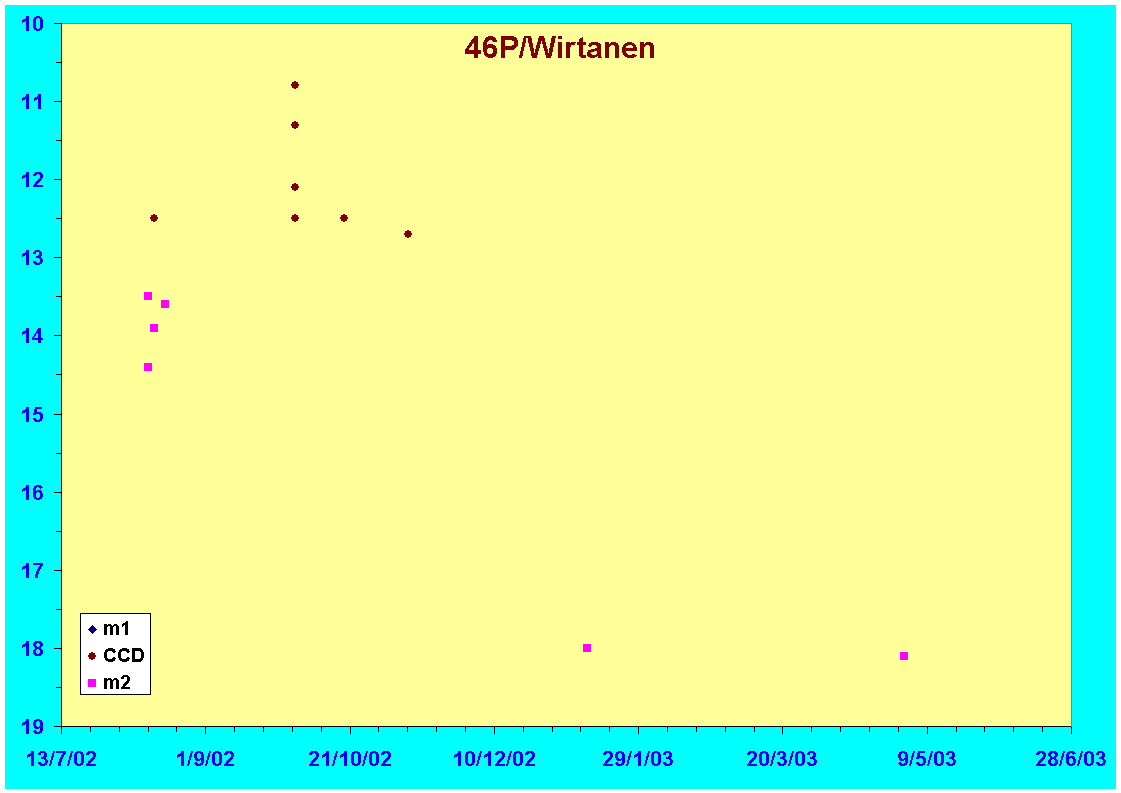46P/Wirtanen
46P/Wirtanen has been observed at 9 appearances (1947, 1954, 1961, 1967,
1974, 1986, 1991, 1997 & 2002). The comet was discovered on
The comet was recovered in 1954 by Carl Wirtanen
himself at Lick, very close to the predicted position, although a rather
fainter object than in 1948. From then the comet was observed at each return
until 1974. At that apparition the comet was extremely faint and had just
suffered a major perturbation by Jupiter that sharply reduced its orbital
period from
The 1980 apparition was similarly unfavorable
to the circumstances in 1974 but, despite the comet's decrease in perihelion
distance, this time it could not be recovered. A new Jupiter encounter brought
the period and perihelion distance sharply down again, this time to 5.5 years
and 1.08AU allowing the theoretical possibility of very close approaches to the
Earth.
The comet's current period is 5.44 years and the perihelion distance has
decreased slightly further to 1.06AU.
This comet was the chosen target for the ESA ROSETTA mission that was to
be launched in January 2003 and encounter the comet in 2014 after two asteroid
fly-bys, and gravity assists from Mars and the Earth. Unfortunately, the Ariane 5 failure in December 2002 led to the suspension of
all ESA launches and the very tight launch window being missed. A mission
profile still exists that would permit an encounter, but only of the more
powerful Russian Proton booster is used. This would imply a launch in late 2004
and an encounter in 2014, some 2 years from perihelion. One of the attractions
of 46P/Wirtanen is its small size and moderate activity. The nucleus is
estimated to be only 1.4km across. Both the main probe and the lander are designed to operate in this small gravity field,
so a mission profile that allows 46P to be encountered still, rather than a
larger comet, is an attractive option.
The 2002
apparition
46P/Wirtanen passed perihelion on August 26th and peaked at magnitude 10. Since then it has been poorly placed for observers in the dawn sky, but appears to have suffered a major outburst as the data (left) from Giovanni Sostero show. Visually the comet may have already reached magnitude 8. Studies of the light curves of periodic comets show that objects that have large decreases in perihelion distance are often unusually active for a number of returns afterwards. The light curve activates very suddenly and shows an extremely rapid rate of brightening (a power law around 18th power, against the "standard" 4th power law).
CCD observations in a 10 arcsecond aperture by:
-
Ramón Naves & Montse Campàs - MPC 213
-
Rolando Ligustri
- MPC 235
-
Albert Sánchez – MPC 442
-
Juan Rodríguez – MPC 620
CCD total magnitude estimates in apertures of 0'.3, 0'.6, 1'.0, 1'.2 and
1'.3 by.
-
Rolando Ligustri
-
Giovanni Sostero
Última
actualización 18/05/2003
Por M.R.Kidger
